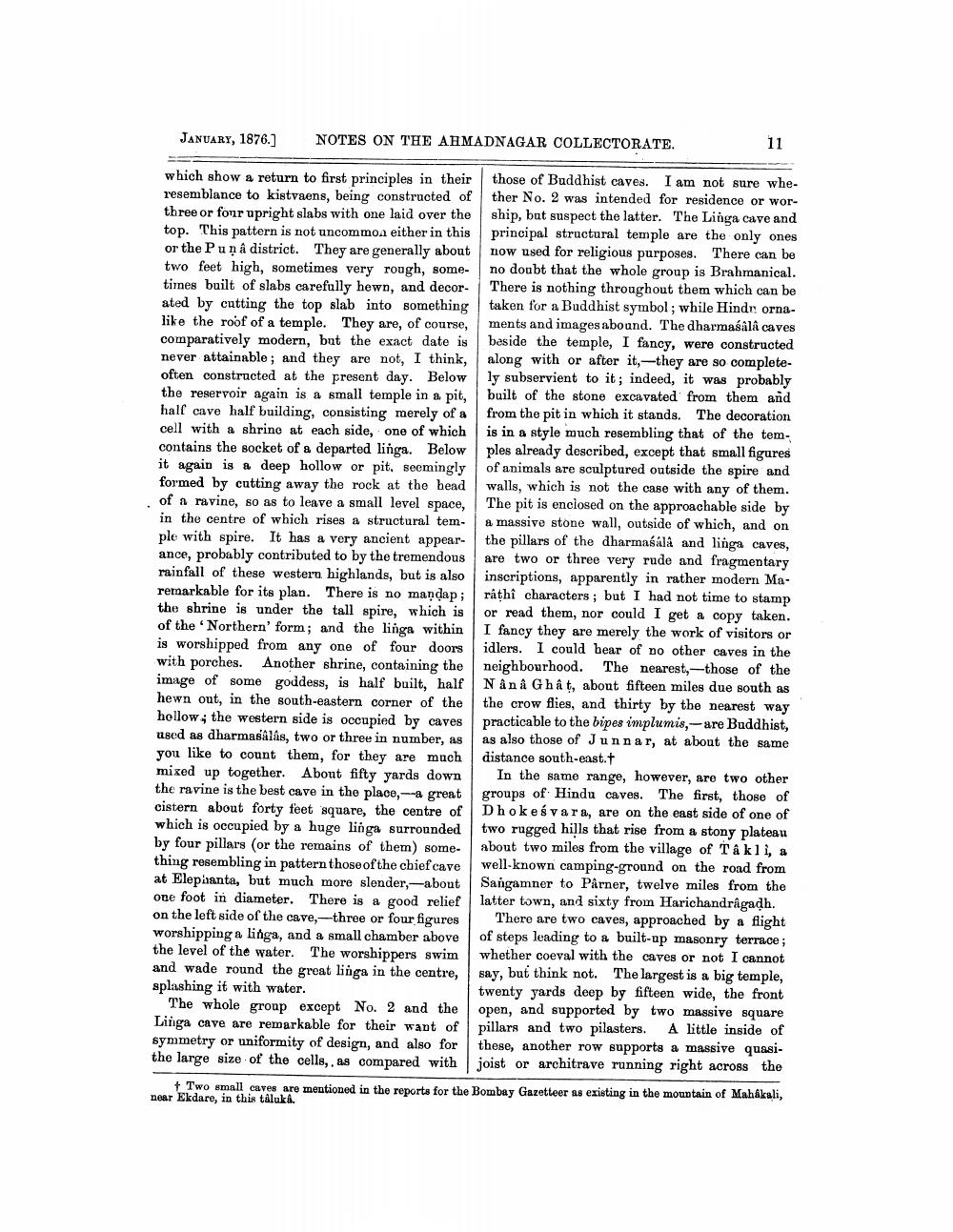________________
JANUARY, 1876.]
NOTES ON THE AHMADNAGAR COLLECTORATE.
11
which show a return to first principles in their those of Buddhist caves. I am not sure wheresemblance to kistvaens, being constructed of ther No. 2 was intended for residence or worthree or four upright slabs with one laid over the ship, bat suspect the latter. The Linga cave and top. This pattern is not uncommon either in this principal structural temple are the only ones or the Puņa district. They are generally about now used for religious purposes. There can be two feet high, sometimes very rough, some- no doubt that the whole group is Brahmanical. times built of slabs carefully hewn, and decor. There is nothing throughout them which can be ated by cutting the top slab into something taken for a Buddhist symbol; while Hindr ornalike the roof of a temple. They are, of course, ments and images abound. The dharmasalî caves comparatively modern, but the exact date is beside the temple, I fancy, were constructed never attainable; and they are not, I think, along with or after it,--they are so completeoften constructed at the present day. Belowly subservient to it; indeed, it was probably the reservoir again is a small temple in a pit, built of the stone excavated from them and half cave half building, consisting merely of a from the pit in which it stands. The decoration cell with a shrine at each side, one of which is in a style much resembling that of the temcontains the socket of a departed linga. Belowples already described, except that small figures it again is a deep hollow or pit, seemingly of animals are sculptured outside the spire and formed by cutting away the rock at the head walls, which is not the case with any of them. of a ravine, so as to leave a small level space, The pit is enclosed on the approachable side by in the centre of which rises a structural tem- a massive stone wall, outside of which, and on ple with spire. It has a very ancient appear- the pillars of the dharmasala and linga caves, ance, probably contributed to by the tremendous are two or three very rude and fragmentary rainfall of these western highlands, but is also inscriptions, apparently in rather modern Maremarkable for its plan. There is no mandap; rathi characters; but I had not time to stamp the shrine is under the tall spire, which is or read them, nor could I get a copy taken. of the Northern' form; and the linga within I fancy they are merely the work of visitors or is worshipped from any one of four doors idlers. I could bear of no other caves in the with porches. Another shrine, containing the neighbourhood. The nearest,-those of the image of some goddess, is half built, half Nana Ghât, about fifteen miles due south as hewn out, in the south-eastern corner of the the crow flies, and thirty by the nearest way hollow, the western side is occupied by caves practicable to the bipes implumis,-are Buddhist, used as dharmasalás, two or three in number, as as also those of Junnar, at about the same you like to count them, for they are much distance south-east. mixed up together. About fifty yards down In the same range, however, are two other the ravine is the best cave in the place, --a great groups of Hindu caves. The first, those of cistern about forty teet square, the centre of Dhokeśvara, are on the east side of one of which is occupied by a huge linga surrounded two rugged hills that rise from a stony plateau by four pillars (or the remains of them) some- about two miles from the village of Tåkli, a thing resembling in pattern those of the chief cave well-known camping-ground on the road from at Elephanta, but much more slender,-about Sangamner to Pârner, twelve miles from the one foot in diameter. There is a good relief latter town, and sixty from Harichandragadh. on the left side of the cave,-three or four figures There are two caves, approached by a flight worshipping a linga, and a small chamber above of steps leading to a built-up masonry terrace ; the level of the water. The worshippers swim whether coeval with the caves or not I cannot and wade round the great linga in the centre, say, but think not. The largest is a big temple, splashing it with water.
twenty yards deep by fifteen wide, the front The whole group except No. 2 and the open, and supported by two massive square Linga cave are remarkable for their want of pillars and two pilasters. A little inside of symmetry or uniformity of design, and also for these, another row supports a massive quasithe large size of the cells, as compared with joist or architrave running right across the
Two small caves are mentioned in the reports for the Bombay Gazetteer as existing in the mountain of Mahakali, near Ekdare, in this taluka.




